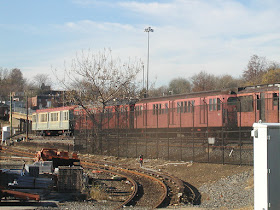Also included in the full set are some photos of the Broad Street Subway and Amtrak's 30th St station complex. I think to save on money, we took the Broad Street Subway to Fern Rock using a PATCO transfer where I shot a few photos of equipment in the ready storage yard and the rolling repair shoppe.
The SEPTA historic fleet was still parked in the upper storage yard, which was slightly easier to photograph.
Clear signal indication on the 4R signal at Tabor Junction as SEPTA SL-IV #305 coasts to a stop on the southbound platform. The interlocking is still in it's ABS configuration with a reverse direction dwarf signal, although the pneumatic point machines have already been replaced.
Example of an ABS signal on the Main Line just south of the recently high-leveled Melrose Park Station.
Medium Clear on the 24L signal at JENKIN interlocking. Trains heading to New York were given the "straight" route to the right. Today all trains are hobbled by an enforced 30mph cab signal indication regardless of the route set.
The flat junction at JENKIN featured a movable point diamond that was replaced in the re-signaling project with a pair of turnouts.
Just past the rusty Reading vintage 315 automatic signal our northbound R5 met a southbound counterpart with SEPTA SL-IV #140 in the lead.
Temporary Block Station GWYNN and it's hand operated trailing point crossover would soon be replaced by a new bi-directional interlocking.
This deep cut near Milepost 21 was originally built as a tunnel, but was daylighted in the 30's as part of the electrification project.
This R5 would continue to Doylwstown and was greeted by a Medium Clear signal indication at DALE interlocking.
A pair of CSX 8800-series SD40-2's sit ahead of another pair of 2700 series GP38-2's at the Lansdale Yard. Later the local freight duties here would be taken over by the East Penn Railroad.
The 8800-series SD402's are known for the exploits of #8888, which went on a 80 odd mile unmanned excursion out in Ohio around the time this photo was taken. #8858 and #8855, shown here, were not early as famous.
Reading era Lansdale Station.
Before re-signaling, Lansdale was home to one of two remaining "crossing towers" in the United States. Due to the complexity of the various train movements, the crossing gates were manually controlled by a man in the little watchtower seen below. The gates were later automated, but trains now face delays creeping forward to trigger the gates before proceeding.
SEPTA Silverliner II #256 at Lansdale. Today the short turn trains terminate at Colmar.
SEPTA SL-IV #413 from Doylestown stopping at Lansdale on the main platform. Today most Doylestown trains will take the parking lot track and stop on the other side of the station.
SEPTA Silverliner III #238 at Glenside.
In 2005 the Circa Center was just being completed along with it's associated parking garage that provided an unspoiled view into Amtrak's Race St engine facility that was free from harassment by low wage security guards.
This night most of the power consisted of grey painted 700 series GP38's along with some brand new 1500 series GP15D's.
That's all for now, see you next time!





















No comments:
Post a Comment